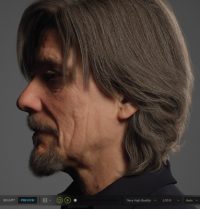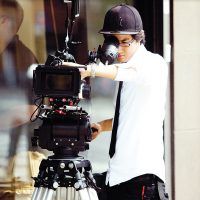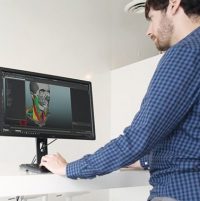VFX Voice – Virtual Production Articles
Enjoy this selection of Virtual Production articles from VES’ VFX Voice Magazine – the award-winning definitive authority on all things visual effects in the world of film, TV, gaming, virtual reality, commercials, theme parks, and other new media.

Setting the Stage for LED Volumes
As with any tool in the film and television industry, the LED volume is being shaped by technological advancements, budgetary requirements and artistic demands, which means the application and capability of the virtual production methodology is constantly changing.

How to Shoot and Edit Animation Using Live-Action Virtual Production
At its heart, this is a conversation about the creative story process itself. The use of real-time tools in animation enables the convergence – or intersection – of animation and live-action techniques. Over the last decade, there have been significant advances in game engines’ readiness for real-time (live) visualization on set and in camera and, in some cases, “final pixel” applications. Stylized hand-key animation can also be produced with this approach.

How Writing for Virtual Production Has Flipped the Script
Combining CGI, real-time visual effects and live-action filming, virtual production technology has boomed in the last few years. With The Mandalorian utilizing the technology, other productions have since followed suit, including 1899, Star Trek: Discovery, House of the Dragon and Avengers: Endgame, among others. The cutting-edge technology has not only become an alternative to on-location filming, but it has opened up endless possibilities for filmmakers, as well as offering a more immersive world for actors to surround themselves in.

How VP Rethinks the Way Stories are Being Told
Today, virtual production encapsulates so many areas – visualization, real-time rendering, LED wall shoots, simulcams, motion capture, volumetric capture and more. With heavy advances made in processing power for real-time workflows, virtual production tools have exploded as filmmaking and storytelling aids. The idea, of course, is to give filmmakers and storytellers more flexible ways to both imagine and then tell their stories, and in that way virtual production has no doubt improved creative outcomes.

LED Stages: The Boom in Equipment and Tech
LED stages have boomed in popularity in a short time and have been used in many high-profile films, series and commercials. While only three LED stages were operating in 2019, that number jumped to 300+ tracked in late 2022 by Epic Games, according to a company spokesperson. The latter number refers only to stages using Unreal Engine, the leading real-time 3D creation tool. The growth of virtual production with LED stages has created a VP ecosystem full of names…

VP Roundtable: On the Surging New Technologies That are Changing the World
The acclaimed science fiction novelist Arthur C. Clarke once said, “Any sufficiently advanced technology is indistinguishable from magic.” It’s not a reach to say that virtual production has not only created magic for the movies, but VP will create magic for most of society in the years to come. VP and its cousin technologies – VFX, virtual reality, AR and others – are destined to transform the world.

Virtual Production: Making a Real Impact in Commercials
We tend to hear a lot about the growing use of LED walls, game engines and real-time tools in the making of film and television shows. It turns out, of course, that these virtual production technologies are also being used in commercials at an equally astonishing rate. Indeed, virtual production can be well-suited to the fast-paced production of commercials, and offers impressive results when actors, characters, vehicles and creatures need to be placed in diverse settings that might not otherwise always be possible to film in.

Into the Volume: Five Innovative Firms with LED Stages Eye Year of Growth
These are the formative years of virtual production, full of challenges and discoveries. Here, executives of five prominent firms with LED stages – DARK BAY, MELS Studios, Virtual Production Studios (80six), Studio Lab and Pixomondo – discuss the arc of their growth and some of their latest developments and innovations.

Roundtable: Virtual Production Lessons Learned on the Ground
Many experienced filmmakers, indie creators, visual effects supervisors and cinematographers have been diving into new virtual production techniques over the past few years as various real-time related technologies become more developed and more accessible. Those who have jumped headfirst into virtual production are still learning the benefits and pitfalls of the various technologies – from LED volumes to virtual camera shooting – while also applying traditional filmmaking techniques to these new sides of the craft.

Perspective: Chasing the Evolving Industry Norm for Virtual Production
What are the prospects for virtual production in the post-pandemic world when global travel and working in closer proximity to one another will become acceptable once again? Will it fade away or become an integral part of the filmmaking toolkit? There is no guarantee when it comes to predictions, especially when trying to envision what the technological landscape is going to look like five years from now.

Deep-Diving into Real-Time Can Offer a Content Creator Instant Benefits
Aaron Sims Creative (ASC), which crafts both concept designs and final visual effects for film, television and games, bridging both the worlds of practical and digital effects, has long delivered content relying on the long-standing ‘traditional’ workflows inherent in crafting creatures and environments. But more recently, ASC has embraced the latest real-time methods to imagine worlds and create final shots. In fact, a new series of films ASC is developing are using game engines at their core, as well as related virtual production techniques.

LED Walls and Stages on the Rise in the U.S. and Europe
With the growth of virtual production, there has been an increased demand for LED walls and stages. Production houses and VFX studios in the U.S. and Europe have built dedicated LED walls, stages and workflows, with more on the way. Some offer bespoke LED wall setups. Here is a sampling that highlights studios with LED walls and stages in a fixed location and those firms that set up bespoke/pop-up LED Volumes.

Video Game Tech and Virtual Production: Four Views in Real-Time
Virtual production would not exist without real-time technology, which the video game industry has been funnelling R&D dollars into for years. That in turn has benefited film and television productions. At the forefront of the innovation is Epic Games, but others have been making their own contributions to further the education of up-and-coming digital artists, as well as authoring computer software that will make work in real-time more photorealistic and efficient.

Zoic Studios and the Lessons Learned from its LED Wall
If there’s one thing changing the way that physical production and visual effects interact right now, it’s the rise of LED walls, also known as LED volumes. LED walls form part of the shift to virtual production and real-time content creation, and have gained prominence by enabling in-camera VFX shots that don’t require additional post-production, offering an alternative to bluescreen or greenscreen shooting, and helping to immerse actors and crews into what will eventually be the final shots.

How VFX Studios are Adopting Virtual Production Into Their Workflows
In the past few years, a number of technological developments – improvements in real-time rendering and game engines and high-fidelity LED wall tech, in particular, and the need for social distancing during the COVID-19 pandemic – have seemed to kickstart visual effects studios into a ‘virtual production’ whirlwind.

Adventures in Indie Virtual Production
Around the world, excitement continues to brew at the filmmaking-related possibilities offered up by virtual production and realtime rendering. This includes independent filmmakers, whose projects might be on a much smaller scale than high-profile virtual production shows such as The Mandalorian and The Lion King.

Virtual Production Takes a Big Step Forward
Traditionally, movies and television shows have been divided into three stages consisting of pre-production, production and post-production; however, the lines are blurring with the advancements in virtual production. A great deal of interest was generated with what Jon Favreau was able to achieve utilizing the technology to produce The Mandalorian. Interest turned into necessity when the coronavirus pandemic restricted the ability to shoot global locations.

Matt Workman: Sharing His Virtual Production Journey as it’s Happening
There’s no doubt that virtual production, and the associated area of real-time, is the hot topic in filmmaking and visual effects right now. Since virtual production is a relatively new area of VFX, information, training and advice on the latest techniques have not always been easy to find for those eager to learn.

New Tech in VFX: Fall Edition
Keeping up with the latest in visual effects tools can be daunting. These past few years have seen major innovations in technology solutions for VFX artists and, as VFX Voice found out, there are many to come. Here’s a roundup of new or recently-launched products that you might already be using, or that you may soon find part of your visual effects production workflow.

New Virtual Technologies Remake VFX’s Future Pipeline
Visual Effects Supervisor Sam Nicholson, ASC, who founded and heads Stargate Studios, remembers the pre-digital processes for visual effects. “I started on Star Trek,” he says. “It was all in-camera effects, shooting film and composting with optical printing.”

Dynamic Duos: DP and VFX – Caleb Deschanel and Rob Legato
On a traditional effects-driven film, a cinematographer and a visual effects supervisor might tend to collaborate predominantly on set on individual visual effects shots, and rarely into post-production. This was the reverse on Jon Favreau’s The Lion King, a photorealistic, computer-generated re-imagining of the classic 2D-animated Disney feature, where Director of Photography Caleb Deschanel, ASC and Visual Effects Supervisor Rob Legato, ASC worked together on every single shot of the film.

Working Remotely: Home Rules for the VFX Industry
Working remotely is part of the regular routine for the visual effects industry; however, with the global lockdown caused by the coronavirus pandemic, the sheer number of individuals requiring offsite access has been unprecedented. Initially, impeding the remote solution were studio concerns about security, which led to an online petition from 10,000 visual effects artists to the Motion Picture Association of America and the Visual Effects Society releasing a statement in support of allowing artists to work remotely.

Instant Feedback: Expozure Expands its Virtual Toolset
In late 2018, virtual production company Digital Monarch Media (DMM) was acquired by game engine maker Unity Technologies. It was a suitable fit, since DMM had been utilizing Unity in its virtual production offerings, while Unity had also been continuing to develop a suite of more accessible filmmaker tools.

VES Handbook: Virtual Production
Merging CG into a live-action shoot allows the director and crew to evaluate composition, lighting, timing, and more, before the final plate is captured. Bringing CG elements into the real world requires a great deal of planning. Avatar (2009) was the first film to use a system that allowed the crew to see a live composite of the CG elements through the eyepiece of the camera and on set monitors.

The Reality of Virtual Filmmaking
It’s easy to think about a film being made by a crew with actors, a set, some lights and a camera. Indeed, many films are still made this way. But as films continue to be imbued with more complex action, and invariably more complex visual effects, filmmakers are turning to new production techniques to imagine these scenes virtually even before they’ve been shot, and then to scout sets, interact live with CG assets and characters, and to shoot, revise and iterate virtual scenes on the fly.
